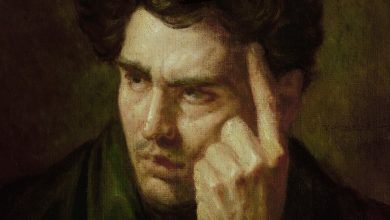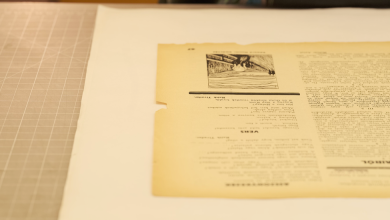The Ecstasy of Scientific Discovery, and Its Agonizing Price

WHEN WE CEASE TO UNDERSTAND THE WORLD
By Benjamín Labatut
Translated by Adrian Nathan West
In December 1915, while serving on the Russian front, the German astronomer and mathematician Karl Schwarzschild sent a letter to Albert Einstein that contained the first precise solution to the equations of general relativity. Schwarzschild’s approach had been simple. He had plugged Einstein’s equations into a model that posited an ideal, perfectly spherical star, in order to calculate how its mass would warp the surrounding space. Schwarzschild’s solution was elegant, but it revealed something monstrous: If the same process were applied not to an ideal star but to one that had begun to collapse, its density and gravity would increase infinitely, creating an enclosed region of space-time, or a singularity, from which nothing could escape. Schwarzschild had given the world its first glimpse of black holes.
In “When We Cease to Understand the World,” a gripping meditation on knowledge and hubris, Benjamín Labatut describes how Schwarzschild was seized by a sense of foreboding over his own discovery. “The true horror” of the singularity, he told a fellow mathematician, was that it created a “blind spot, fundamentally unknowable,” since even light would be unable to escape it. And what if, he continued, something similar could occur in the human psyche? “Could a sufficient concentration of human will — millions of people exploited for a single end with their minds compressed into the same psychic space — unleash something comparable to the singularity? Schwarzschild was convinced that such a thing was not only possible, but was actually taking place in the Fatherland.”
Schwarzschild, who was Jewish, did not live to see Hitler rise to power and concentrate the collective German will to catastrophic effect. But a different premonition came true within months. The “void without form or dimension,” which he told his wife had invaded his being, took shape as a rare disease that would cover his body in pustulant blisters and kill him mere months after his scientific breakthrough.
Labatut, a Chilean novelist born in 1980 in the Netherlands, casts the flickering light of Gothic fiction on 20th-century science. In five free-floating vignettes, he illuminates the kinship of knowledge and destruction, brilliance and madness. He draws a line from the invention of a synthetic color in the 18th century to chemical warfare in World War I to the Zyklon B agent used in Nazi gas chambers. He relives the vertigo that can grip scientists on the precipice of discoveries, like Schwarzschild’s time-scrambling singularity or the German physicist Werner Heisenberg’s theory of indeterminacy. He retraces the trajectories of two brilliant mathematicians, Shinichi Mochizuki and Alexander Grothendieck, who after solving hitherto intractable problems, obscured or destroyed their own work and withdrew into eremitic silence. And he takes the reader into the heart of the battle to understand the quantum world, pitting Heisenberg’s matrix mechanics against Erwin Schrödinger’s wave equation, efforts that laid the groundwork for both Hiroshima and the internet.
Labatut’s gallery of tormented scientists features no women, though Marie Curie would have fit the profile well as both genius and martyr. Instead, it is the specter of Mary Shelley that seems to guide the author’s hand as he magnifies the nightmarish, repulsive or bizarre moments that affect the course of the history of science.
In any case, the individual characters are merely vehicles for Labatut. His true subject is the ecstasy of scientific discovery and the price it exacts — from the individuals who sacrifice everything in its pursuit, and from the human species, which gains ever more powerful tools to master a world that keeps eluding comprehension.
In the final chapter, we encounter a reclusive gardener who had once been a mathematician but “now speaks of mathematics as former alcoholics speak of booze, with a mixture of fear and longing.” The man, who gardens only at night because he maintains that plants suffer less if they are handled in their sleep, believes that “it was mathematics — not nuclear weapons, computers, biological warfare or our climate Armageddon — which was changing our world to the point where, in a couple of decades at most, we would simply not be able to grasp what being human really meant.”
That night gardener is one of the few invented characters in a book otherwise built on real events. The mix of fact and fiction is in itself common, but Labatut’s formula is unusual. As he explains in an author’s note, the amount of invented material grows over the course of the book. The opening chapter stays close to the facts in its account of Fritz Haber, the chemist who saved countless lives from starvation when he figured out how to harvest nitrogen from the air, creating a plentiful supply of fertilizer, but who also caused the agonizing deaths of countless soldiers in World War I as the guiding force behind Germany’s chemical weapons program. According to Labatut, that chapter contains only a single paragraph of fiction.
From there — as if growing out of that single impurity — dialogue, dreams and hallucinations proliferate. (Labatut’s imagination may run lurid, but his prose is masterfully paced and vividly rendered in Adrian Nathan West’s magnetic translation.) Thus the reader witnesses Heisenberg’s matrix epiphany on the remote North Sea island of Heligoland not as a breakthrough in esoteric algebra, but as revelation induced by fever and accompanied by visions.
The historical record confirms that Heisenberg arrived on Heligoland delirious with allergies. It’s known that he had a copy of Goethe’s “West-Eastern Divan” and memorized passages from it. But the hallucination in which the German naturalist and polymath Goethe fellates the lifeless body of Hafez, the 14th-century Sufi poet whose verses had inspired his Divan, is all Labatut’s. Modern science may have replaced mysticism as a path to knowledge, he seems to say, but it’s shattered our holistic understanding of our world.
Labatut has Heisenberg suffer another mental breakdown on the cusp of a scientific breakthrough, this time in Copenhagen, where he arrived at the uncertainty principle now named for him. In a seedy bar, he is accosted by a stranger who works in radio and confronts the German scientist about the “magnificent inferno” created by technologies that can warp distance and time. Stumbling out into the night, Heisenberg is overcome by a prefiguration of the nuclear bomb his research will make possible, a vision of tiny sparks dancing before his eyes, and a mute chorus of shadowy figures who throng around him before a flash of “blind” — not blinding — light obliterates them.
In Labatut’s telling, Heisenberg then comes to recognize that the parameters of any given quantum object can never be identified with certainty. If the position of an electron is determined precisely, “arresting that particle in its orbit like an insect impaled on a pin,” then it becomes impossible to know its momentum, and vice versa. The variables are mathematically complementary, so that the more clearly we bring one into focus, the more it blurs our understanding of the other — as if, Heisenberg explains, “reality allowed us to perceive the world with crystalline clarity with one eye at a time, but never with both.”
With his slippery hybrid of fact and fiction, Labatut slyly applies the uncertainty principle to the human pursuit of knowledge itself. Abstraction and imagination, measurement and story coexist in a multidimensional reality containing infinite destinies and interpretations. At its furthest reaches, reason and scientific inquiry lead into the unknowable. As Labatut puts it, in words he ascribes to Schwarzschild: “Only a vision of the whole, like that of a saint, a madman or a mystic, will permit us to decipher the true organizing principles of the universe.”




